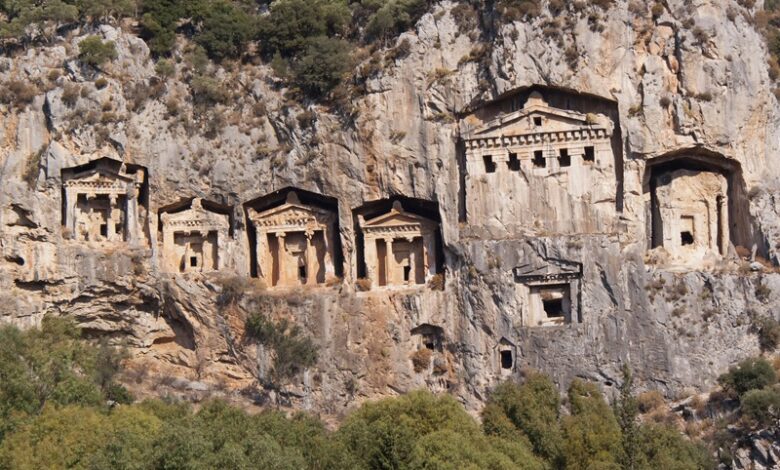Rock-Cut Architecture: 9 Fascinating Buildings Carved Out of Mountains, Stones, and Hills
News Mania Desk / Piyal Chatterjee/ 6th January 2025

Chiseled directly from the core of lofty cliffs and rough terrains, rock-cut architecture possesses an undeniable grandeur—specifically, structures sculpted straight from mountains, stone, and hills. Frequently centuries (if not longer) old, these architectural wonders serve as stunning symbols of human creativity and craftsmanship even now. Covering various continents and cultures, these edifices were frequently built for religious devotion, communal living, or defense; examine the structures of these cliff faces to witness the foundational beliefs of the societies that crafted them.
From the historic temples of Egypt and India to complete villages in Turkey and Iran, every building was crafted with meticulous care. These are remarkable achievements, in both literal and figurative senses, that honor the connection between architecture and geology.
Presented below are 9 remarkable instances of rock-cut architecture, revealing architectural genius carved into stone.
Petra (Jordan)
During its prime, Petra served as the prosperous capital of the Nabataean Kingdom. Chiseled from pink-hued cliffs, this historic city, formerly a major trade center, showcases façades and tombs from the 4th century BCE. A respected World Heritage Site, its significant characteristics encompass not just the intricate tombs and temples, a system of reservoirs, and numerous thoughtfully maintained tunnels and channels, but also the “blend of Hellenistic architectural fronts with traditional Nabataean rock-hewn temple/tombs…a distinctive artistic accomplishment and an exceptional architectural group,” as noted in its designation. Additionally, a treat for cinema enthusiasts: Petra’s Treasury, displayed here, was prominently showcased in the film Indiana Jones and the Last Crusade (1989).
The Kaunos Lycian Tombs (Turkey)
The Lycians, an ancient civilization in Anatolia, viewed the practice of carving tombs into mountains as both a practical decision and a symbolic act, as they allegedly believed angels transported the deceased to the afterlife. Certainly, it is believed that the high location of these tombs was meant to assist the departed in their voyage. A masterclass in fusing Greek and Anatolian architectural designs, the tombs resemble the fronts of magnificent Hellenistic temples.
Ellora Caves (India)
Featuring 34 monasteries and temples, these remarkable edifices were hewn into basalt cliffs uninterruptedly for 400 years, spanning from 600 to 1000 AD. A World Heritage site, “its temples dedicated to Buddhism, Hinduism, and Jainism… [reflect] the essence of tolerance that defined ancient India.” In addition to its remarkable attributes, one of its most impressive edifices, the Kailasa Temple, shown here, ranks among the largest rock-cut monolithic structures globally. Approximately 200,000 tons of rock needed to be removed, but it was accomplished in just 20 years, showcasing exceptional ancient engineering.
Cliff Palace (United States)
The highlight of Mesa Verde National Park in Colorado, Cliff Palace is the biggest cliff dwelling in North America, constructed by the Ancestral Puebloans approximately in 1190 AD. Nestled within a sandstone alcove, the Cliff Palace features an impressive 150 rooms and 23 kivas (sacred spaces). While the exact cause for its abandonment around 1300 AD is still unclear, possible explanations are drought, depletion of resources, or social transformation.
Vardzia (Georgia)
Skillfully chiseled into the slopes of the Erusheti Mountain, Vardzia was built in the 12th century by King George III of the Bagrationi dynasty as a fortress-monastery for defense against attacks. It includes more than 6,000 rooms, chapels, and tunnels linked by complex stairways and corridors.
Temples of Abu Simbel (Egypt)
Unquestionable examples of ancient Egyptian architecture, these temples were constructed to align with the sun biannually to light up the inner sanctum. Directly hewn from the sandstone mountain, the largest temple features massive sculptures of the pharaoh alongside smaller figures of his family. The temple’s corridors are upheld by large columns embellished with carvings, and the walls are artistically adorned with hieroglyphics and reliefs. During the 1960s, the temples were moved to elevated terrain to prevent flooding, a remarkable engineering achievement almost as impressive as their initial construction.
Meymand Village (Iran)
Currently home to semi-nomadic shepherds during certain seasons, Meymand Village stands as a vibrant example of age-old customs. Hidden within the valley of Iran’s central mountains, the village’s distinctive architecture features hand-carved dwellings, called “kiches,” sculpted directly into the soft rock of the nearby mountains and crafted to offer insulation from the area’s severe climate. Having been inhabited for more than 3,000 years, it’s clear that the bonds between the community and the natural surroundings are still robust.
Churches Carved from Rock in Ivanovo (Bulgaria)
This monastic complex from the medieval period was hewn into the limestone cliffs during the 12th to 14th centuries. It showcases a unique architectural style and remarkable craftsmanship, with the interiors of churches, chapels, and monastic cells adorned with lively frescoes that merge Byzantine and Bulgarian artistic influences. As stated by its UNESCO World Heritage status, “these frescoes, due to their profound expressiveness, exceed all other historical monuments found, emblematic of the Palaeologues style.”






